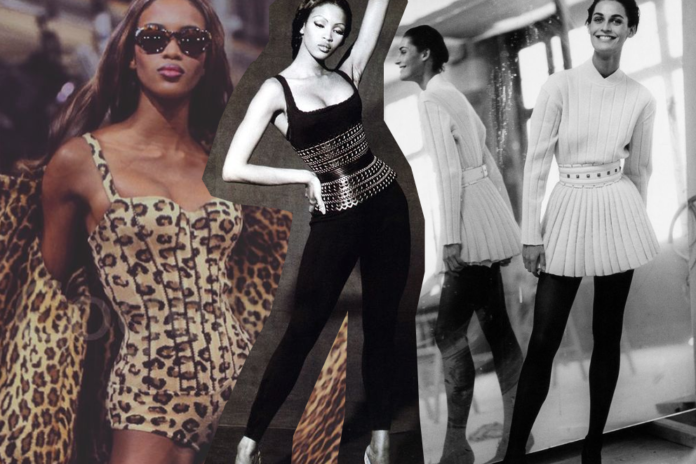


Images via Pinterest.com / Edited by Katherine Peña Rios
[tabs]
[tab title=”EN”] Who was Azzedine Alaïa? Creator of Maison Alaïa, Tunisian designer Azzedine Alaïa earned the admiration and respect of an audience who granted him the title of King of Cling.
Azzedine Alaïa grew up in Tunis with his grand parents and his sister, from which he inherited his love for fashion. He entered École des Beaux Arts in Tunisia to study sculpture and after graduating, he travelled to fashion capital Paris, where he began his career working for Christian Dior, Guy Laroche and Thierry Mugler.
In the 1970s, he opened his first atelier in Parisian district Le Marais, and it wasn’t until the 1980s when he decided to launch his first collection. Alaïa set his brand and his style in fashion world; nonetheless, he stayed true to dressmaking art and no to
what the industry represents. The King of Cling rarely participated in Fashion Weeks; instead, he presented his collections only when he was certain they were ready.
Azzedine Alaïa had a deep admiration for women and he used to say that he dedicated all of his work to them. His designs depict his admiration, in a way that they highlight women’s attributes when they wear them. He’s internationally well known as the creator of the bodycon dress, which is tight clothing that adapts to the body, accentuating its natural curves; he truly was the King of Cling.
Azzedine Alaïa imposed himself upon a scheduled fashion industry that ended up by accepting his habits with a smile on; he also boosted the career of one of the most recognized supermodels of all time, Naomi Campbell. Finally, he lived working for his passion and demonstrating us that this is the only way to get ahead and be successful.
“My obsession is to make women beautiful. When you create with that in mind, things
can’t go out of fashion.” (Alaïa)
“A small man but huge in the world of fashion.” (Inès de la Fressange)
[/tab]
[tab title=”ES”]¿Quién fue Azzedine Alaïa? El creador de la Maison Alaïa, Azzedine Alaïa, fue un diseñador de origen tunecino que se ganó la admiración y el respeto de un público que le concedió el nombre de Escultor de la Moda.
Azzedine Alaïa creció con sus abuelos en Túnez y fue su hermana gemela quien despertó su amor por la moda. Pasó por la Escuela de Bellas Artes en su país de origen, donde estudió escultura; después de graduarse, se aventuró en un viaje a la capital de la moda, Paris, para comenzar su trayectoria colaborando con Christian Dior, Guy Laroche y Thierry Mugler.
En los años 70, abrió su primer atelier en el barrio parisino Le Marais y no fue hasta los años 80, que decidió lanzar su primera colección. Alaïa imprimió su marca y su estilo en el mundo de la moda, sin embargo, siempre se mantuvo fiel al arte de la confección y no a la industria. El Escultor de la Moda rara vez participó en los desfiles de la semana de la moda, en vez, presentaba sus colecciones cuando él decidía que estaban listas.
Alaïa tenía una profunda admiración por las mujeres y afirmaba que su trabajo estaba completamente dedicado a ellas. Sus diseños plasman materialmente esta admiración, puesto que resaltan los atributos de cada una de las mujeres que vestía. Es reconocido internacionalmente como el creador del vestido bodycon, que es una prenda ajustada y que se adapta al cuerpo acentuando las curvas naturales; verdaderamente era un Escultor de la Moda.
Azzedine Alaïa se impuso ante una industria de la moda calendarizada que terminó por aceptar con una sonrisa los hábitos del diseñador, impulsó la trayectoria de una de las supermodelos más reconocidas de todos los tiempos, Naomi Campbell y vivió trabajando por su pasión, demostrando que es la única manera de salir adelante y
triunfar.
“Tengo una obsesión por hacer que las mujeres sean bellas. Cuando creas teniendo eso
en mente, nada puede estar fuera de moda.” (Alaïa)
“Un pequeño hombre que es un grande dentro del mundo de la moda.” (Inès de la
Fressange)
[/tab]
[/tabs]





